Trinity River Audubon Center
Surprising Place in the Urban Forest6500 South Great Trinity Forest Way
Dallas, TX 75215
The Trinity River Audubon Center is located eight miles south of downtown Dallas and can be easily reached by traveling IH-45 South to Loop 12 East. This beautiful forest destination is a perfect place to take a break from the everyday and to experience world-class birding adventure and the great outdoors without traveling to the Hill Country or a different state.
This LEED ® Gold (Leadership in Energy and Environmental Design) certified center is a keystone for sustainability in Dallas and it represents the new era of outdoor adventure and environmental awareness that interests all of us. More than 100,000 visitors have been amazed by this story of land reclamation and the site of beautiful forest trails and birds! Built by the City of Dallas and managed by the National Audubon Society, this center is actually the experience of a lifetime right in the heart of Dallas. What is the expression? We never appreciate what we have in our own backyard. This center is something that should be experienced and enjoyed by families and individuals again and again throughout each year.
The 21,000 sq. ft. building was designed by Antoine Predock, a renowned architect and it is surrounded by restored Blackland Prairie, emerging wetlands and acres of bottomland hardwood forest that play host to harrier hawks in winter and bloom with a snowy show from the blossoms of the hawthorn trees in the spring.
In addition to world-class bird watching of over 300 types of birds that either live or migrate across North Texas on their annual journey south for the winter, outdoor conservation programs and interesting clubs play an important role at this teaching facility. The Trinity River Audubon Center features wet laboratories as well as field Eco-investigation programs for people of all ages. The teaching curriculum provides an amazing alternative for those difficult-to-grasp biology and science concepts.
John Flicker, president of the National Audubon Society said, "One of my passions and a key priority for Audubon is connecting people with nature, whether they live in urban, suburban or rural areas." To achieve this goal, and as part of Audubon's effort to engage broader and more diverse audiences, many events and programs make up the weekly plans at the Trinity River Audubon Center such as: Celebrate Bird Fest, Turtlepaloosa and the exclusive Scissortail and Cocktails Fundraiser.
Another benefit of the Trinity River Audubon Center will be the growing trend of ecotourism in Texas, already a $1 billion industry. A major part of that trend is birding. Tourism is the third largest industry in Texas overall, after oil and gas production and agriculture. Birding in Texas generates more than $350 million per year from 2.2 million participants, approximately one-quarter of which travel here from outside of the state. (sources: U.S. Department of the Interior, 2003; Dean Runyon Associates, 2005).
Because of where the Trinity River is located in Texas, it is the largest fresh water inflow into Galveston Bay. The Trinity River is critical for birds because it is a migratory pass between the northern and southern hemispheres. More than 600 migratory species come into Texas, the most of any state in the nation. The Trinity River Audubon Center is closely affiliated with such top national ornithology centers such as Cornell University's Lab of Ornithology. This lab provides them their eBird tracking system, so people can go birding and then enter the birds they sight into the national system. Through Cornell, there is also streaming video of nesting birds and other interesting activities to view.
The Trinity River Audubon Center also has a citizen science manager, who will work with Cornell on enhancing the Dallas citizen science program, as Cornell is well known for its citizen science program. This affiliation also provides an opportunity to showcase some of Cornell Lab of Ornithology's research and science documentaries to the students and visitors. The staff and visitors see a stunning variety of birds and wildlife, including many winter birds. Visitors have reported seeing a beaver that was 3ft long (not including the tail!), and wild hogs, and deer tracks have been spotted. Among the birds seen are an American Gold Finch, Dark Eyed Junco, Greater Roadrunner, White Crowned Sparrows, White Throated Sparrows, Gadwall Ducks, Mallards, American Pigeon, Pintail Ducks, American Coots, Roseatte Spoonbills, Northern Harrier Hawk, Barred Owl, Little Blue Heron, Great White Egret, Snowy Egrets, Cardinals, Chickadees, Red Tailed Hawk, and even a Pileated Woodpecker, the largest woodpecker in North America.
Special thanks goes to the following foundations for their generous gifts for the building's sustainability features: The Meadows Foundation (also for educational programs), The Boone Family Foundation and the Eugene McDermott Foundation.
General Information The price of admission is $6.00 for Adults (ages 13-59), $3.00 for Children (ages 3-12), $4.00 for Seniors (60+); children two and under are admitted free. Annual memberships start at $60 and group rates are available. The Center is located at 6500 S. Great Trinity Forest Way, Dallas, TX 75217. For a complete list of activities or more information call 214-370-9967 or visit www.trinityriveraudubon.org. Admission to the Trinity River Audubon Center is free the third Thursday of each month with hours of operation from 9:00 a.m. until 9:00 p.m. on those days.


